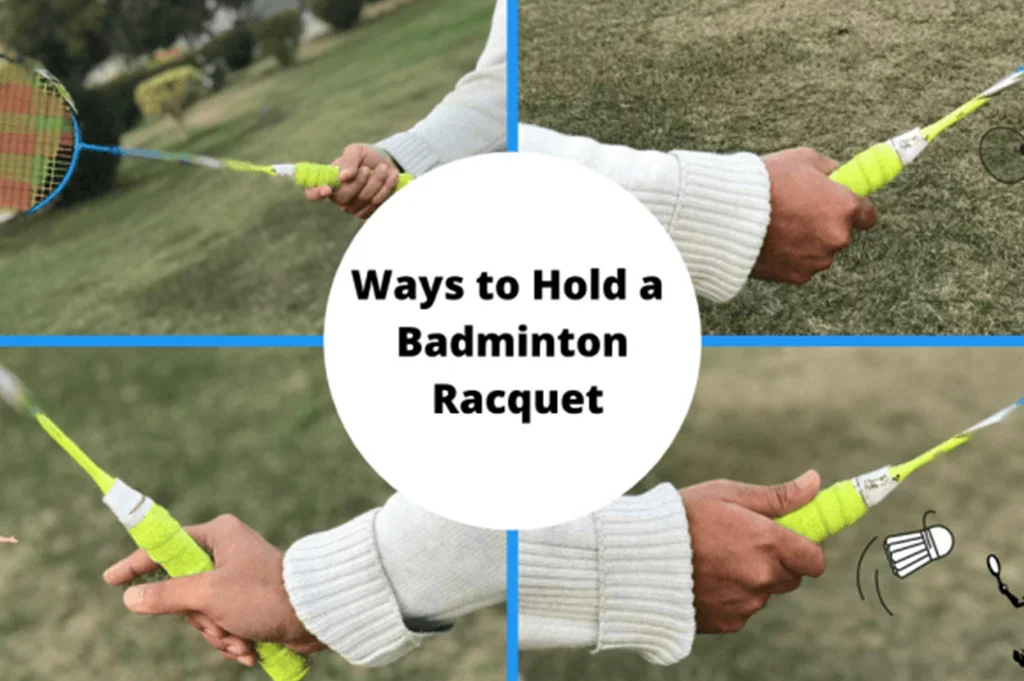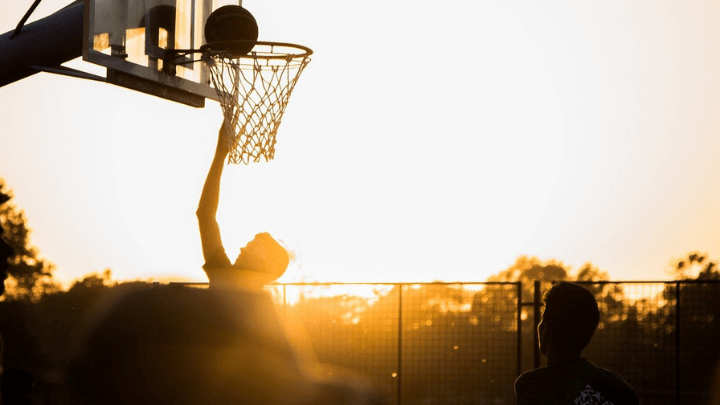
Within this guide, you will discover:
- What the different types of badminton grips are?
- How to hold each badminton grip (with image/video examples)
- When to use these badminton grips during your game
So if you want to see new ways to hold your badminton racquet, you’ll love today’s checklist.
Let’s dive right in…
Table of Contents
How many types of grips are there in badminton?
- The forehand grip
- The backhand grip
- The Panhandle (Hammer) grip
- How to hold a badminton racquet whilst playing a net shot?
- How hard should you hold a badminton racquet?
- How to hold a badminton racquet whilst smashing?
- Which grip is like you are shaking hands in badminton?
- What is the role of the last two fingers when gripping the badminton racquet?
- Conclusion
How Many Types of Grips Are There in Badminton?
Broadly categorizing, there are four significant grips in badminton that with practice, can help you become an even better badminton player. The grips are:
- The Forehand Grip
- The Backhand Grip
- The Panhandle Grip
You can use these different gripping techniques to deliver various kinds of strokes in badminton when returning shots from your opponent.
The Forehand Grip
How to Hold the Forehand Grip in Badminton
To hold a forehand grip in badminton, perform the following steps:
Step 1: Imitate a handshake posture with your stronger hand.
Step 2: Gently hold the middle of the racquet, with your thumb, middle finger, ring finger, and little finger or pinkie being careful. Your index finger will be at the highest point of the handle. Your thumb will be a bit lower, near the middle finger.
Note: Avoid gripping the handle too tightly. If your grip is too firm, your wrist movement will not be flexible.
Step 3: Looking down at how you’re holding your racquet, you will notice that your thumb and index finger will form a V-shape. This is a good tip to check if you are holding the correct forehand grip.
Step 4: The grip should be gentle (meaning someone could easily pull your racquet away from you), and you should squeeze only at the time of playing a stroke.
Why Do We Use the Forehand Grip in Badminton?
The forehand grip is one of the most used grips in badminton for both overhead and underhand strokes.
By utilizing the forehand grip, you can play forehand strokes (strokes on your right side if you’re right-handed, or, strokes on your left hand side if you’re left-handed).
Having a good forehand grip is one of the most fundamental skills of badminton that takes years to master.
The Backhand Grip
How to Hold a Backhand Grip in Badminton
There are two types of backhand grips in badminton:
a) The Backhand Clear Grip
b) The Underarm Backhand Clear Grip
How to hold a backhand clear grip:
Step 1: Hold the racquet so that the face is perpendicular to the court.
Step 2: Start with the forehand grip and turn it around 45 degrees.
Step 3: If you’re right-handed, the V-shape from the forehand is now leftwards instead of rightwards.
Step 4: Place your thumb on the handle where the vertical and horizontal portion of the racquet is intersecting.
Step 5: Ensure that the racquet is not in your palm, but loosely placed in your fingers.
Step 6: Tighten the grip only while playing a stroke for maximum control.
How to hold an underarm backhand clear grip:
Step 1: Hold the racquet so that the face is perpendicular to the court.
Step 2: Start with the forehand grip and turn it around 45 degrees.
Step 3: If you’re right-handed, the V-shape from the forehand is now leftwards instead of rightwards.
Step 4: Place your thumb on the flat side of your racquet handle.
Step 5: Make sure that there is little space between the palm and the racquet handle.
Step 6: Ensure you’re holding the racquet from your thumb and fingers only (not your palm).
Step 7: Keep the grip relaxed and tighten it only right before the shuttlecock impact for maximum control.
Why Do We Use the Backhand Grip in Badminton?
The backhand grip is used for returning the strokes coming toward the non-dominant hand of your body.
If you are right-handed, the shots coming to your left side will be handled using the backhand grip and vice versa.
If you tried to use a forehand grip to return a shot on your non racquet side, you’ll likely lose your balance and miss the shot as the angle will be off.
The Panhandle (Hammer) Grip
How to Hold a Panhandle (Hammer) Grip in Badminton
Step 1: As the name suggests, the panhandle grip is akin to holding a cooking pan in your hand.
Step 2: Relax your fingers, and gently hold the racquet handle with your thumb and fingers, leaving space between the palm and the racquet handle.
Step 3: Face the shuttlecock with the flat face of your racquet.
Step 4: Use your thumb along with the middle and index fingers to perform the reply stroke.
Why Do We Use the Panhandle Grip in Badminton?
The panhandle grip (also known as ‘Net Tap Grip’ or ‘Pan Hold Grip’, or ‘Hammer Grip’) helps you to hit the shuttlecock from the frontcourt to perform a forehand net kill.
This grip allows you to hit the shuttlecock with a flat face.
If you tried to use the backhand/forehand grip when dealing with a net kill you’ll find it very difficult because it would be much slower in comparison to the panhandle grip.
How to Hold a Badminton Racquet Whilst Playing a Net Shot
There are two different kinds of net shots – the forehand net shot and the backhand net shot. Hence, the associated grips are also different.
Be it the forehand or backhand net shot, the most important thing to remember is to hold your racquet loosely.
If you are holding the racquet tightly, you might struggle to execute a good net shot.
For a forehand net shot, hold the racquet as you would in a forehand grip, but with the racquet in your fingers rather than the palm.
You will rotate the racquet using your fingers and wrist.
The magnitude of force with which you execute a net shot is essential, so ensure that the racquet can rotate in your fingers for the execution of the forehand net stroke.
For a backhand net shot, hold the racquet in your backhand grip.
The position of the racquet for this shot is such that the racquet is loosely held in your fingers.
Gently put your thumb between the horizontal and vertical plane of your racquet handle. Ensure that the racquet is slightly away from the palm and in your fingers.
How Hard Should You Hold a Badminton Racquet?
It is imperative that you hold the racquet gently.
Why?
First, if you hold a racquet too tightly, it will restrict your wrist movement. The hindered wrist movement will, in turn, lead to less flexibility and thus: ineffective shots.
Regardless of how much power you use, flexibility is a critical element of badminton.
Second, with a hard grip (and restricted movement), you might injure your wrist.
As a general rule of thumb for each shot, you must lightly hold the racquet and squeeze only during the shot execution.
How to Hold a Badminton Racquet Whilst Smashing?
One of the best practices in badminton is to hold the racquet gently, yet firmly.
The crucial aspect of holding a racquet whilst smashing is that there must not be any tension in your body.
If you hold the racquet too tightly, then the pressure will restrict your movement which can result in poor smashes.
To deliver a high-quality smash, get into the smashing position and squeeze the grip slightly just before the shuttlecock makes contact with your racquet.
Which Grip is Like You Are Shaking Hands in Badminton?
The forehand grip in badminton is similar to shaking hands with someone and a V-shape should be formed between your thumb and index finger.
What is the Role of the Last Two Fingers When Gripping the Badminton Racquet?
The last two fingers play the role of comfortably balancing the weight of the racquet in your hand during a forehand grip.
When holding your racquet with the forehand grip, your hand will be present in the middle and your index finger will be present at the highest point of the handle, with your middle finger resting underneath your thumb.
This will provide greater freedom of movement for the wrist.
Conclusion
I hope that you found our step-by-step guide to handle different shots in badminton useful.
I also hope that you will be able to employ the techniques mentioned above during your next match.
Now I’d like to turn it over to you:
What badminton grip are you going to practice next?
Did you know what grip is similar to shaking hands in badminton?
Let me know by leaving a quick comment below right now.
Next – More Essential Badminton Skills
Now that you’ve learnt all about badminton racket holds, take a look at The Ultimate Guide to Badminton Skills: Mastering Every Aspect of the Game.












